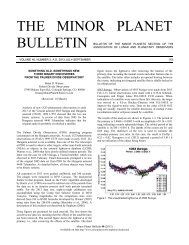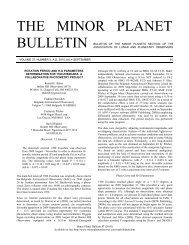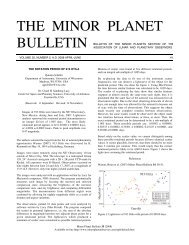THE MINOR PLANET BULLETIN - MinorPlanet.Info
THE MINOR PLANET BULLETIN - MinorPlanet.Info
THE MINOR PLANET BULLETIN - MinorPlanet.Info
- No tags were found...
You also want an ePaper? Increase the reach of your titles
YUMPU automatically turns print PDFs into web optimized ePapers that Google loves.
123<br />
ASTEROID LIGHTCURVE ANALYSIS AT<br />
RICKY OBSERVATORY<br />
Craig Bennefeld<br />
Physics Dept., Imagine Renaissance Academy<br />
414 Wallace<br />
Kansas City, Missouri. 64125<br />
craig.bennefeld@imagineschools.com<br />
Science Department Students<br />
Vanessa Aguilar, Terrance Cooper, William Hupp,<br />
Jeanne Pecha, Elysabeth Soar<br />
(Received: 2009 Apr 15)<br />
Lightcurves for six asteroids were obtained at Ricky<br />
Observatory from 2007 October through 2008 January:<br />
802 Epyaxa, 1666 Van Gent, 2320 Blarney, 2358<br />
Bahner, 2509 Chukota, 3416 Dorrit.<br />
Observations of the 6 asteroids were carried out at Bennefeld’s<br />
Observatory (MPC H46), which is equipped with a 0.35m Meade<br />
LX200 GPS telescope operating at f/6.3 coupled to a SBIG ST7-<br />
XME CCD camera, resulting in a resolution of ~1.7 arcsec/pixel<br />
(binned 2×2). Unfiltered exposure times varied between 30-60 s.<br />
The asteroids under observation were selected from the list of<br />
asteroid lightcurve photometry opportunities which is posted on<br />
the Collaborative Asteroid Lightcurve Link (CALL) website<br />
(Warner, 2007a). The students measured the photometric<br />
properties of the images using Brian Warner’s MPO Canopus,<br />
which employs differential aperture photometry to produce the<br />
raw data (Warner, 2007b). Period analysis of the raw data was<br />
done using Canopus, which incorporates the Fourier analysis<br />
algorithm developed by Harris (Harris et al., 1989). As well as<br />
reporting the synodic rotational period, amplitude, and phase angle<br />
of the asteroids, every attempt was made to expand on the<br />
knowledge base of the asteroids by, where appropriate, reporting<br />
the minimum axial ratio a/b of an elliptical asteroid and the Phase<br />
Angle Bisector longitude and latitude, PAB L and PAB B ,<br />
respectively.<br />
802 Epyaxa. This main-belt asteroid was sampled 434 times over<br />
3 nights to achieve a synodic rotation period of 4.389 ± 0.001 h.<br />
The absolute value of the peak-to-peak magnitude differential<br />
(∆m) of 0.58 mag implies an axial ratio (a/b) of 1.70, assuming an<br />
equatorial viewing aspect. The period agrees with Warner (2009).<br />
1666 van Gent. The main-belt asteroid was sampled 156 times<br />
over 2 nights to yield a synodic rotation period of 4.166 ± 0.003 h.<br />
The absolute value of the peak-to-peak magnitude differential<br />
(∆m) of 0.50 mag implies an axial ratio (a/b) of 1.58. No other<br />
lightcurves for this asteroid are known to exist.<br />
2320 Blarney. The main-belt asteroid was sampled 154 times over<br />
a single night to yield a synodic rotation period of 5.097 ± 0.001 h.<br />
The absolute value of the peak-to-peak magnitude differential is<br />
0.44 mag, implying an axial ratio (a/b) of 1.50. No other<br />
lightcurves for this asteroid are known to exist.<br />
2358 Bahner. This main-belt asteroid was sampled 226 times over<br />
a 4 night period to yield a synodic rotation period of 14.194 ±<br />
0.002 h. Due to an incomplete data set, the axial ratio was not<br />
computed. Behrend (2009) reports a provisional period of 10.848<br />
± 0.003 h and Owings (2009) a period of 10.855 h. We did test our<br />
data against the shorter period but found a lower RMS fit for the<br />
longer period. Given the lack of consecutive nights and the<br />
incomplete coverage of the curve in our data set, we admit that our<br />
solution may not correct and so present it here more for the<br />
purpose of putting our data on record.<br />
2509 Chukotka. This main-belt asteroid was sampled 431 times<br />
over a 4 night period to yield a synodic rotation period of 3.19 ±<br />
0.01 h. Due to the poor SNR and the inconclusive nature of the<br />
lightcurve, no attempt was made to calculate the axial ratio. No<br />
other lightcurves for this asteroid are known to exist.<br />
3416 Dorrit. This Mars-crossing asteroid was sampled 247 times<br />
over a 2 night period to yield a synodic rotation period of 2.714 ±<br />
0.003 h. The absolute value of the peak-to-peak magnitude<br />
differential is 0.38 mag, implying an axial ratio (a/b) of 1.42. No<br />
other lightcurves for this asteroid are known to exist.<br />
Acknowledgements<br />
The students would like to thank the entire staff at Imagine<br />
Renaissance Academy (Wallace Campus) including Mrs. Debbie<br />
Jones-Fowler, Head of Schools, Mr. Geoffrey Alderman, Assistant<br />
Director, and Mr. Greg McGhee, Activities Director, for striving<br />
to provide us with a project-based learning environment second to<br />
none. Thanks also go out to Mr. Brian D. Warner for his input in<br />
the preparation of this paper and finally to Mr. Bennefeld our<br />
Physics and Astronomy teacher.<br />
References<br />
Behrend, R. (2009). “Asteroids and Comets Rotation Curves,<br />
CdR.” http://obswww.unige.ch/~behrend/page4cou.html.<br />
Harris, A.W., Young, J.W., Bowell, E., Martin, L.J., Millis, R.L.,<br />
Poutanen, M., Scaltriti, F., Zappala, V., Schober, H.J., Debehogne,<br />
H., and Zeigler, K.W., (1989). “Photoelectric Observations of<br />
Asteroids 3, 24, 60, 261, and 863.” Icarus 77, 171-186.<br />
Owings, L.E. “Lightcurves for 155 Scylla and 2358 Bahner”.<br />
Minor Planet Bul. 36, 51-52.<br />
# Name<br />
Date Range<br />
(mm/dd)<br />
Data Pts Phase PAB L PAB B<br />
Per<br />
(h)<br />
PE Amp AE<br />
802 Epyaxa 11/15-18/2008 434 6.05 104.4 7.6 4.389 0.002 0.58 0.02<br />
1666 van Gent 12/31/2008-01/01/2009 156 18.57 66.3 0.5 4.166 0.003 0.50 0.03<br />
2320 Blarney 01/01/2009 154 1.66 103.2 -3.9 5.097 0.001 0.44 0.02<br />
2358 Bahner 10/26-11/25/2008 226 13.50 12.9 6.8 14.194 0.001 0.44 0.01<br />
2509 Chukotka 09/29-10/29/2008 431 14.3 358.2 1.4 3.19 0.01 0.16 0.03<br />
3416 Dorrit 11/19-11/20/2008 247 19.03 31.9 12.1 2.714 0.003 0.38 0.03<br />
Minor Planet Bulletin 36 (2009)










